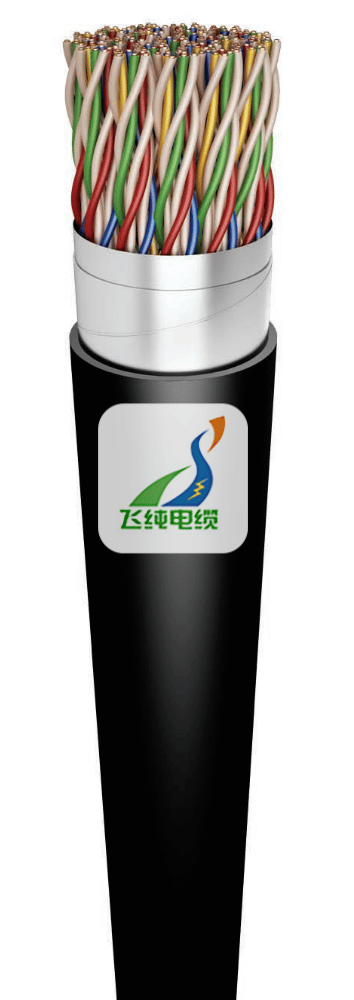Type YTKGXFoyn & YTKGXFtyn & YTKGXFtlyn Mine shielded mine communication cable
PVC inner coating
Coating color Black (RAL 9005)
Reinforcement
Foy – Steel wire and tape
Fty – Steel tape measure
Ftl – Painted steel tape
Casing: Flame retardant PVC
Coating color Black (RAL 9005)


Type YTKGXFoyn, YTKGXFtyn, and YTKGXFtlyn cables are high-performance, shielded mine communication cables designed specifically for the harsh conditions found in underground mining environments.
These cables provide reliable telecommunications and signaling connections, even in areas with high electromagnetic interference and challenging mechanical stresses. They are engineered to ensure robust data transmission for mining machinery and communication systems.
Construction and Materials
Conductors and Insulation
Conductors:
Each cable contains a copper conductor with a diameter of 0.8 mm. These conductors are insulated with high-quality polyethylene (PE), which offers excellent dielectric properties and durability.
Conductor Identification:
The cable supports multiple pairs for communication. Each pair is individually identified by color coding (red, blue, green, yellow for primary pairs, with additional pairs in natural colors), ensuring clear signal routing for direction and counting purposes.
Inner Coating and Reinforcement
Inner Coating:
The internal layer of the cable is made from PVC. This inner coating is black (RAL 9005), providing mechanical protection and electrical insulation.
Reinforcement Options:
Three reinforcement variants are available:Foy: Reinforced with a combination of steel wires and a steel tape.
Fty: Reinforced with a steel tape.
Ftl: Reinforced with a painted steel tape.
These reinforcement options enhance the cable’s mechanical strength and protect it against physical damage in rugged mining environments.
Outer Jacket
Casing:
The outer jacket is constructed from flame-retardant PVC, also colored black (RAL 9005). This non-diffusing, flame-resistant casing not only protects the cable from environmental hazards but also helps prevent the spread of fire in case of an incident.
Electrical and Mechanical Characteristics
Resistance and Insulation:
Pair Resistance: The maximum resistance of a pair is 73.6 Ω/km, ensuring low signal loss over long distances.
Insulation Resistance: A minimum of 5000 MΩ×km, which guarantees reliable electrical performance even under demanding conditions.
Capacitance:
The effective capacitance is 60 µF/km at 800 Hz, critical for maintaining signal integrity in telecommunications.
Bending Radius:
The cable’s minimum bending radius is 15 times its external diameter (15D), allowing for flexible installations without risking damage.
Temperature Range:
Operating Temperature: –5°C to +50°C.
Installation Temperature: –15°C to +60°C.
These ranges ensure the cable can perform reliably under varying underground conditions.
Applications
These mine communication cables are ideally suited for:
Telecommunications Installations:
Providing robust data transmission in mining tunnels and shafts.
Signaling Systems:
Used in mine safety and operational signaling systems.
Mining Machinery:
Integrating into the communication systems of mining equipment, ensuring continuous operation in harsh environments.
Variants and Construction Details
The cable is available in various configurations with differing numbers of pairs:
Pair Configurations:
Options include 5, 10, 16, 24, 33, 56, and 60 pairs. The internal layering is specifically arranged for each variant:For example, a 5-pair cable may have all pairs in a single layer, while higher-pair cables distribute pairs across multiple layers (first, second, third, and even fourth layers).
Dimensional Specifications:
Detailed construction parameters for each variant include:Inner Coating Thickness: Ranges from approximately 1.4 mm to 1.6 mm (±0.1 mm).
Outer Coating Thickness: Ranges from 1.5 mm to 1.9 mm (±0.2 mm).
Steel Wire Diameter: Typically around 1.4–1.8 mm.
Steel Tape Thickness: Varies from 0.3 mm to 0.5 mm.
External Diameter: Ranges from about 14.1 mm for a 5-pair cable up to 32.2 mm for a 60-pair cable.
These precise specifications ensure the cable meets the required mechanical and electrical performance standards for underground mining communications.
Standards and Compliance
Standards:
The cable complies with the specification ZN 86/MH 80iMP 13 K12098 and meets the requirements of specification TT1-6260.Environmental Compliance:
The cable is RoHS compliant, ensuring the use of environmentally friendly materials and restricted hazardous substances.

Frequently Asked Questions (FAQ)
Q: What is the primary purpose of these cables?
A: They are designed for reliable mine communications and signaling in underground mining environments.
Q: Which cable variants are available?
A: The cables come in three variants based on reinforcement: YTKGXFoyn (steel wires and tape), YTKGXFtyn (steel tape), and YTKGXFtlyn (painted steel tape).
Q: What material is used for the inner coating?
A: The inner coating is made of PVC, colored black (RAL 9005).
Q: What is the outer casing made of?
A: The outer casing is constructed from flame-retardant PVC, also in black (RAL 9005).
Q: What is the diameter of the copper conductor?
A: The cable features a 0.8 mm diameter copper conductor.
Q: What type of insulation is used on the conductor?
A: The conductor is insulated with high-quality polyethylene (PE).
Q: How are the conductor pairs identified?
A: Conductor pairs are color-coded (e.g., red, blue, green, yellow for the main pairs) to facilitate easy identification for telecommunications and signaling.
Q: What is the maximum resistance per pair?
A: The maximum pair resistance is 73.6 Ω/km.Q: What is the minimum insulation resistance specified?
A: The cable has a minimum insulation resistance of 5000 MΩ×km.Q: What is the effective capacitance of the cable?
A: It has an effective capacitance of 60 µF/km at 800 Hz, which is critical for maintaining signal quality.
Q: What is the minimum bending radius for this cable?
A: The cable should not be bent below a radius of 15 times its external diameter (15D).
Q: What is the operating temperature range?
A: The cable operates reliably between –5°C and +50°C.
Q: What is the installation temperature range?
A: It can be installed in temperatures ranging from –15°C to +60°C.
Q: What is the function of the reinforcement layer?
A: The reinforcement layer, available in different types (Foy, Fty, Ftl), increases mechanical strength and protects the cable in harsh environments.
Q: How does the flame-retardant outer jacket contribute to safety?
A: It helps prevent the spread of fire, a crucial feature in hazardous underground conditions.
Q: What standards do these cables comply with?
A: They conform to the specifications ZN 86/MH 80iMP 13 K12098 and TT1-6260, ensuring quality and performance.
Q: What are the primary applications of these cables?
A: They are used for telecommunications, signaling, and communications in mining machinery within underground mines.
Q: How does the shielded design benefit mine communications?
A: The shielding minimizes electromagnetic interference (EMI), ensuring clear and reliable signal transmission in noisy environments.
Q: What are the color specifications for the cable coatings?
A: Both the inner and outer coatings are black (RAL 9005), providing a uniform appearance and high contrast for identification.
Q: How does the cable withstand mechanical stresses?
A: Its robust construction with reinforced layers and flame-retardant materials protects it against physical damage in rugged mine environments.
Q: Can the cable support high data transmission rates?
A: Yes, its low capacitance and high insulation resistance support high-quality signal transmission essential for modern mine communications.
Q: What are the benefits of the different reinforcement types?
A:Foy: Combines steel wires and tape for extra strength.
Fty: Uses steel tape for robust reinforcement.
Ftl: Utilizes painted steel tape for added corrosion resistance and aesthetic consistency.
Q: How does the cable ensure long-term reliability?
A: It is built to rigorous standards with materials designed to withstand harsh underground conditions, ensuring consistent performance over time.
Q: What makes this cable suitable for use in mining tunnels and shafts?
A: Its flexible design, strict bending radius, and high mechanical strength make it ideal for installation in confined and rugged environments.
Q: How are the cable pairs arranged?
A: The cable can be configured in multiple pair counts (e.g., 5, 10, 16, 24, 33, 56, or 60 pairs) arranged in one or more layers, tailored to specific communication needs.
Q: What factors determine the choice of cable pair configuration?
A: The number of pairs needed depends on the complexity of the communication system, with higher pair counts supporting more complex signaling.
Q: How does the cable manage signal integrity over long distances?
A: Its high insulation resistance, low capacitance, and effective shielding ensure minimal signal loss, even over extended lengths.
Q: Why is low effective capacitance important in communication cables?
A: Lower capacitance helps reduce signal delay and distortion, ensuring clearer and more reliable data transmission.
Q: How does the cable perform under electromagnetic interference?
A: Its shielded design, combined with individual pair insulation, minimizes interference, which is vital in electrically noisy mining environments.
Q: Is this cable RoHS compliant?
A: Yes, the cable is designed to meet RoHS requirements, ensuring the use of environmentally friendly materials.
Q: What maintenance practices are recommended for these cables in a mining environment?
A: Regular inspections, cleaning, and adherence to installation guidelines (such as proper bending radius and temperature ranges) are essential to maintain performance and longevity.






Type YTKGXFoyn, YTKGXFtyn, & YTKGXFtlyn Mine Shielded Communication Cable
A high-performance, flame-retardant cable engineered for reliable telecommunications in underground mining environments. Designed with a robust PVC inner coating and a matching flame-retardant PVC outer jacket (Black RAL 9005), this cable delivers superior protection against harsh conditions and electromagnetic interference. It features a 0.8 mm copper conductor insulated with polyethylene, and supports multiple pair configurations for flexible communications. Reinforcement options include steel wires combined with tape (Foy), steel tape (Fty), or painted steel tape (Ftl), ensuring enhanced mechanical strength and durability. Ideal for mining tunnels, shafts, and equipment, this cable meets stringent industry standards and is built to perform in extreme temperatures, making it the perfect solution for modern mine telecommunications and signaling systems.
6/30/20216 min read
